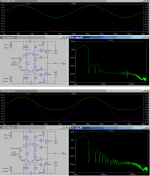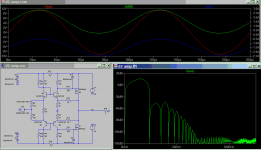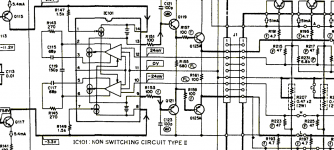D2S? pioneer d2s?
link attachment:
http://www.diyaudio.com/forums/soli...erview-negative-feedback-291.html#post1879411
http://www.diyaudio.com/forums/solid-state/189766-square-law-class-amps.html
link attachment:
http://www.diyaudio.com/forums/soli...erview-negative-feedback-291.html#post1879411
http://www.diyaudio.com/forums/solid-state/189766-square-law-class-amps.html
Last edited:
Ken Peter
Hi Homemodder,
I don't know of any paper, but here you can see the schematic.
His design is a bit different. First, no local feedback around the OPS. Second, the bias control approaches the geometric mean (or hyperbolic) relationship between Ip and In in a different way. Instead of turning off the sense tranny at higher currents, in his design they are turned on by the logarithm of Ip respectively In (by means of Schottky diodes). In this way, in principle, the hyperbolic relationship is more accurate approximated. However, its difficult to match Vd of Schottky diodes with Vbe of transistors. Please look here for a more stable version.
Cheers,
E.
Edmond
...........
Nice results, could you direct me to Ken Peters paper, I must have missed it.
...........
Hi Homemodder,
I don't know of any paper, but here you can see the schematic.
His design is a bit different. First, no local feedback around the OPS. Second, the bias control approaches the geometric mean (or hyperbolic) relationship between Ip and In in a different way. Instead of turning off the sense tranny at higher currents, in his design they are turned on by the logarithm of Ip respectively In (by means of Schottky diodes). In this way, in principle, the hyperbolic relationship is more accurate approximated. However, its difficult to match Vd of Schottky diodes with Vbe of transistors. Please look here for a more stable version.
Cheers,
E.
Last edited:
The links are correct. A shame I forgot to mention Ian Hegglun, as he is the one who elaborated on the D2S concept. See:
"Square law rules in Audio Power", EW+WW, Sept. 1995, pp. 751- 756.
Cheers,
E.
Edmond,
Ian Hegglun elaborates about square law class A designs in his Linear Audio Vol 1 article: 'Square-law class-A: a family of high-efficiency class-A power amplifiers'.
This article treats issues beyond the design and the transfer function itself like efficiency calculations for square-law and curved-law, comparing favourably with for instance the Pass ZV5 and the well-known JLH class-A amp. Also treats issues like heatsink and power transformer requirements and the impact of using different output MOSFET devices.
jan didden
D2S
Hi Jan,
Did Ian Hegglun also compare D2S to AB2? If so, I'm eager to learn more (and buy a copy of Vol.1 ).
).
Cheers,
E.
Edmond,
[snip]
This article treats issues beyond the design and the transfer function itself like efficiency calculations for square-law and curved-law, comparing favourably with for instance the Pass ZV5 and the well-known JLH class-A amp.
[snip]
jan didden
Hi Jan,
Did Ian Hegglun also compare D2S to AB2? If so, I'm eager to learn more (and buy a copy of Vol.1
Cheers,
E.
There is still huge crossover distortion from that square law application (hegglun sch) even for 200mA bias. The most effective is Candy's style that added drop voltages to input plus remaining drop voltages to input again.
Is there any explanation why square law not perform so good in linear audio vol1?
About Kenpeter, he using current based negative feedback similar with this: http://www.diyaudio.com/forums/atta...roject-bjt-classb-buffering-bjt-se-classa.png
http://www.diyaudio.com/forums/atta...ass-hybrid-power-dac-project-60w-tripleef.png
but with schottky nonlinearity.
Is there any explanation why square law not perform so good in linear audio vol1?
About Kenpeter, he using current based negative feedback similar with this: http://www.diyaudio.com/forums/atta...roject-bjt-classb-buffering-bjt-se-classa.png
http://www.diyaudio.com/forums/atta...ass-hybrid-power-dac-project-60w-tripleef.png
but with schottky nonlinearity.
Last edited:
Hi Jan,
Did Ian Hegglun also compare D2S to AB2? If so, I'm eager to learn more (and buy a copy of Vol.1).
Cheers,
E.
Ian's starting point is a class A amp but with much better efficiency. It's a real class A amp; if you look at the (measured) wingspread diagrams you'll see no ripples or discontinuities at the zero crossing. The distortion as such is not the lowest ever, but due to the transfer it is very benign. This is open loop, and he has a section on adding gain and feedback to make the distortion lower but that is not a prime consideration.
There an extensive section on the use of various types of MOSFETs and the impact on efficiency and performance.
In Appendix A he gives extensive info on efficiency comparisons for music signals between his square-law class-A, conventional class-A and class-B, with square-law class-A falling somewhere between the other two.
Of course, long-term efficiency depends on the type of music you play; for classical music linear class-A has about 3%, square-law class-A 8% and class-B 25%, while for sine waves the figures are 50%, 67% and 78%.
Another interesting tabel gives the ratio of power supply transformer VA to amp output power; for conventional class-A this is 6 (!) and for square-law class-A it is 3.2. So a 100W conventional class-A needs a 600VA xformer, while Ian's 100W version needs only a 320VA one.
Then Appendix B goes into the distortion analysis for the various topologies. This includes damping factor/ Zout as well.
Total article runs 36 pages.
Other articles you might be interested in are Ed Simon's article on resistor non-linearity and Scott Wurcer's first part of his low noise mic preamp. And several more - abstracts can be read on the website.
jan
Ian's starting point is a class A amp but with much better efficiency. It's a real class A amp.
....
In Appendix A he gives extensive info on efficiency comparisons for music signals between his square-law class-A, conventional class-A and class-B, with square-law class-A falling somewhere between the other two.
....
jan
Hi, Jan,
I could make AB2+XM or my original XM to not doing switch at all for all freq up to 2ohm load working at smooth current curves with biasing the storage, the result must be much better efficiency compared to that square law, because dynamic biasing depend on freq and load, but it is not necessary I think. Sound quality is one most important and 0.005% THD is enough to get its clarity.
Is there any listening comparison between square-law and original classA?
This is not so good performance. Just 8ohm and 4 ohm.
I am using Pawel's asc thanks for his drawing: http://www.diyaudio.com/forums/solid-state/189766-square-law-class-amps.html#post2853130
I am using Pawel's asc thanks for his drawing: http://www.diyaudio.com/forums/solid-state/189766-square-law-class-amps.html#post2853130
Attachments
This is not so good performance. Just 8ohm and 4 ohm.
I am using Pawel's asc thanks for his drawing: http://www.diyaudio.com/forums/solid-state/189766-square-law-class-amps.html#post2853130
Is2 is clipped due to too low quiescent current.
If you use shorter timestep - you will get more acurate results - try like in the file sent by me
so where the differences?
1nS timestep:
hf harmonics are -120 - 150 dB now, before ~-90dB
I agree that the bias is high but probably it would not sound sharp nor sandy. It looks like d2 technique cancels only hf harmonics but does it very good... The 2nd and the 3rd are still dominant...
but no hf hiss
Here is pioneer non switching circuit Type 1, this was used in more than 50 models of their amps between 1975 to 1990, Type 2 was improvement on this scheme but I havent been able to locate its patent as yet.
Attachments
True, the type 2 I believe uses feedback, maybe someone here has enough time to sim this Type 1 and see how well it does compaired to the other circuits, its much simpler. Ill keep digging for the type 2.
The square law amp distortion looks good but if it means much higher dissipation its not worth it although the paper states its efficiency as 75 %, just below class AB. I like the simplicity though.
The square law amp distortion looks good but if it means much higher dissipation its not worth it although the paper states its efficiency as 75 %, just below class AB. I like the simplicity though.
Pioneer patent
Simpler? It uses four trannies and four current sources, just the same as the bias control part of AB2. But that's no all. in AB2 the matched trannies have the same size. The Pioneer amp on the other hand, relies on scaled down copies of the output trannies. That makes things not easier. Moreover, as the nominal bias setting relies only on (slow) thermal feedback, it can't compete with auto-bias circuits, that rely on (instant) electrical FB. Sorry, but I'm not going to simulate it and waste my time on this inferior patent.
Are you sure? Not worth the effort if it still relies on thermal FB.
I don't like simplicity at the expense of performance. Besides, common source (or emitter) topologies have worse properties at HF.
Cheers,
E.
True, the type 2 I believe uses feedback, maybe someone here has enough time to sim this Type 1 and see how well it does compared to the other circuits, its much simpler.
Simpler? It uses four trannies and four current sources, just the same as the bias control part of AB2. But that's no all. in AB2 the matched trannies have the same size. The Pioneer amp on the other hand, relies on scaled down copies of the output trannies. That makes things not easier. Moreover, as the nominal bias setting relies only on (slow) thermal feedback, it can't compete with auto-bias circuits, that rely on (instant) electrical FB. Sorry, but I'm not going to simulate it and waste my time on this inferior patent.
Ill keep digging for the type 2.
Are you sure? Not worth the effort if it still relies on thermal FB.
The square law amp distortion looks good but if it means much higher dissipation its not worth it although the paper states its efficiency as 75 %, just below class AB. I like the simplicity though.
I don't like simplicity at the expense of performance. Besides, common source (or emitter) topologies have worse properties at HF.
Cheers,
E.
It looks like d2 technique cancels only hf harmonics but does it very good...
Hf harmonics will still present when it operating in classAB, because it is classA, there is non switching mechanism.
Here is pioneer non switching circuit Type 1, this was used in more than 50 models of their amps between 1975 to 1990, Type 2 was improvement on this scheme but I havent been able to locate its patent as yet.
Looks like type I is all non switching transistors, but this type may degrade some error correcting results (non switching but higher drop voltage).
From that type II IC picture, it is similar with nakayama's circuit. It has current sense and three inputs of differential amplifier.
NCS-II = PA0016
Hi ontoaba,
If you want to repair the bad channel, just buy that chip: Pioneer Electronics (USA) Inc. Parts & Accessories Online - Part Number: PA0016 Information ,
because it's almost impossible to copy it by means of discrete trannies.
BTW1,maybe other components are also defective.
BTW2, the PA0016 is pretty expensive.
>204mA bias ?
According to the schematic on page .. it's 51mA per OP tranny.
Cheers,
E.
[snip]
Hi, Edmond, can't it modified to something that not need transistor matching? Because pioneer that uses special IC also sometimes one channel perform right, and other channel just worse.
Pioneer has 204mA bias.
Hi ontoaba,
If you want to repair the bad channel, just buy that chip: Pioneer Electronics (USA) Inc. Parts & Accessories Online - Part Number: PA0016 Information ,
because it's almost impossible to copy it by means of discrete trannies.
BTW1,maybe other components are also defective.
BTW2, the PA0016 is pretty expensive.
>204mA bias ?
According to the schematic on page .. it's 51mA per OP tranny.
Cheers,
E.
- Status
- This old topic is closed. If you want to reopen this topic, contact a moderator using the "Report Post" button.
- Home
- Amplifiers
- Solid State
- Class i and siblings


